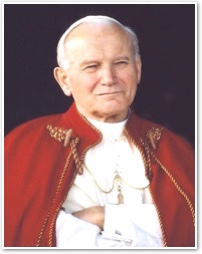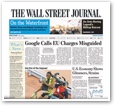Pope John Paul II’s Soviet Spy
- GEORGE WEIGEL
Students of the Cold War's dark arts know that Communist intelligence services deeply penetrated the Vatican in the 1970s.
 Yet few know that Pope John Paul II, whose centenary was marked on May 18, had his own secret agent in the Soviet Union during the 1980s. That relationship led to a remarkable personal encounter that helps explain what made the pope the man he was.
Yet few know that Pope John Paul II, whose centenary was marked on May 18, had his own secret agent in the Soviet Union during the 1980s. That relationship led to a remarkable personal encounter that helps explain what made the pope the man he was.
John Paul's unlikely 007 was Irina Ilovayskaya Alberti, the Russian-born widow of an Italian diplomat. A former personal assistant to Alexander Solzhenitsyn in Vermont, she met the pope quite by accident during a papal audience in the early 1980s. A friendship quickly developed between them. As the Gorbachev thaw made access to the U.S.S.R. easier, Alberti traveled to the country several times a year. "If I learned anything interesting," she told me years later, "I'd call the pope, we'd meet, and I'd tell him." Vatican diplomats, who liked to keep such matters on close hold, didn't appreciate that kind of back channel. But John Paul had a habit of going around his mandarins when he thought doing so might yield useful information. He ignored the traditional managers and kept in touch with his clandestine operative.
As it happened, Alberti was also a friend of Yelena Bonner, the tough-minded wife of Soviet nuclear physicist and human-rights campaigner Andrei Sakharov. Under house arrest in 1985, Sakharov went on a hunger strike and demanded Soviet officials let his wife leave the country for critical medical care. The authorities finally agreed, but Sakharov was hostage to Bonner's good behavior abroad. That meant no meetings with world leaders or the press.
Alberti still thought Bonner should meet the pope. When she came to Rome after her medical treatment, Alberti organized a subterfuge that had the Roman press corps chasing Bonner's children as she drove the recovering dissident into Vatican City, incognito. Emotionally hardened by decades of battling the KGB, Bonner wasn't given to sentimentality. Nor was she religious. Yet a two-hour, one-on-one meeting with Pope John Paul II left her sobbing. She told Alberti afterward, "He's the most incredible man I've ever met. He's all light. He is a source of light."
The Bonner-John Paul II relationship continued for years and eventually led to a lengthy private meeting between the pope and Sakharov, who sought advice about playing a political role in the endgame of the U.S.S.R. It was that first meeting with Bonner — and her reaction to this Pole, a man she had never met before and the leader of a faith she didn't share — that is worth pondering on John Paul's centenary, though.
How did Pope John Paul II touch hearts and minds, even those of unbelievers, the way he did? He was a man of probing intelligence, an experienced pastor, a polyglot and a shrewd operator on the world stage. His commitment to basic human rights, irrespective of religious conviction or the lack thereof, had been demonstrated time and again during his years as archbishop of Krakow and as pope. He had paid the price of that advocacy with his own blood, surviving an assassination attempt that he certainly suspected had been initiated in Moscow.
But that curriculum vitae and that credibility do not explain why a tearful nonbeliever should say, "He is all light. He is a source of light." Or why, in his last years, wracked by Parkinson's disease, he could still draw vast crowds and lift the spirits of the suffering.
Pope John Paul II cannot be explained or understood unless he is taken for what he said he was: a radically converted Christian disciple. He believed that God had revealed himself in history, first to the Jewish people and ultimately in Jesus of Nazareth. He believed that the resurrection of the crucified Nazarene was the axial point of the human saga: an event in and beyond what we know as "history," which disclosed that God's passionate love for humanity was stronger than death itself.
Believing that, he lived without fear. And living without fear, he inspired fearlessness in others. He was "a source of light" because he spent his life allowing what he had experienced as divine light to shine through him.
 This is Meaghen Gonzalez, Editor of CERC. I hope you appreciated this piece. We curate these articles especially for believers like you.
This is Meaghen Gonzalez, Editor of CERC. I hope you appreciated this piece. We curate these articles especially for believers like you.
Please show your appreciation by making a $3 donation. CERC is entirely reader supported.

Acknowledgement
 George Weigel. "Pope John Paul II’s Soviet Spy." The Wall Street Journal (May 14, 2020).
George Weigel. "Pope John Paul II’s Soviet Spy." The Wall Street Journal (May 14, 2020).
Reprinted with permission of the author and The Wall Street Journal © 2020 Dow Jones & Company, Inc. All rights reserved.
The Author

 George Weigel is a Distinguished Senior Fellow of the Ethics and Public Policy Center in Washington, D.C. He is author of The Fragility of Order: Catholic Reflections on Turbulent Times; Lessons in Hope: My Unexpected Life with St. John Paul II; Evangelical Catholicism: Deep Reform in the 21st-Century Catholic Church; Witness to Hope: The Biography of Pope John Paul II; Roman Pilgrimage: The Station Churches; Evangelical Catholicism; The End and the Beginning: John Paul II—The Victory of Freedom, the Last Years, the Legacy; God's Choice: Pope Benedict XVI and the Future of the Catholic Church; Letters to a Young Catholic: The Art of Mentoring; The Courage to Be Catholic: Crisis, Reform, and the Future of the Church; and The Truth of Catholicism: Ten Controversies Explored.
George Weigel is a Distinguished Senior Fellow of the Ethics and Public Policy Center in Washington, D.C. He is author of The Fragility of Order: Catholic Reflections on Turbulent Times; Lessons in Hope: My Unexpected Life with St. John Paul II; Evangelical Catholicism: Deep Reform in the 21st-Century Catholic Church; Witness to Hope: The Biography of Pope John Paul II; Roman Pilgrimage: The Station Churches; Evangelical Catholicism; The End and the Beginning: John Paul II—The Victory of Freedom, the Last Years, the Legacy; God's Choice: Pope Benedict XVI and the Future of the Catholic Church; Letters to a Young Catholic: The Art of Mentoring; The Courage to Be Catholic: Crisis, Reform, and the Future of the Church; and The Truth of Catholicism: Ten Controversies Explored.




